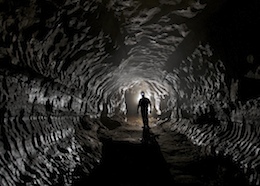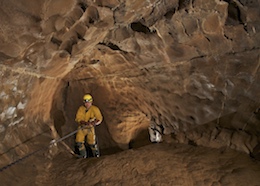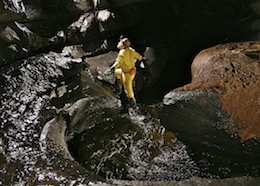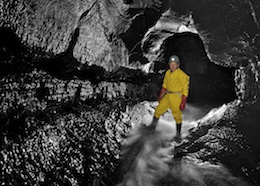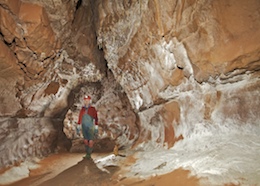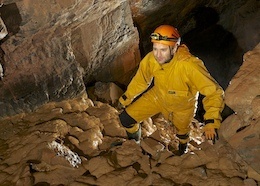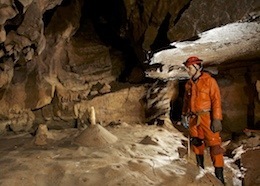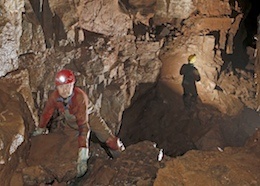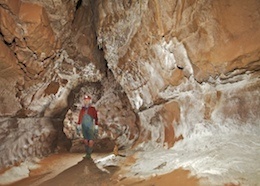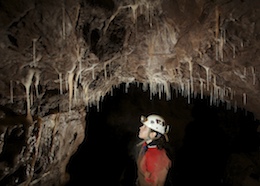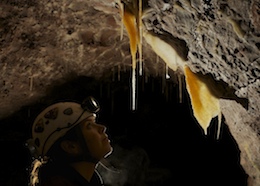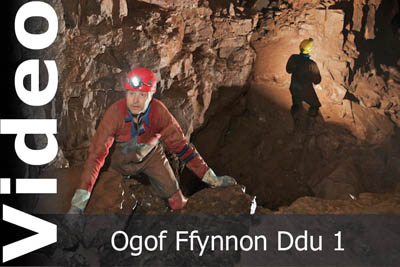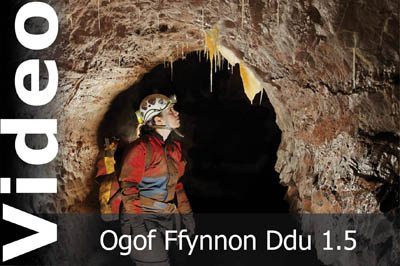Overview
Ogof Ffynnon Ddu 1 or OFD1 as it is more often abbreviated to has one of the finest streamways of any cave in the country. This stream cuts through the jet-black limestone producing impressive cascades, deep pots and superbly scalloped walls. From the stream a route can be taken through to Cwm Dwr, OFD2 and the further reaches of the system, or you are able to climb up into the higher fossil passages to complete the Escape Route and one of the best round trips available.Length 60,600m - approximate length of the entire OFD system
Altitude 204m
Grid SN 84786 15210
History
Ffynnon Ddu - The Black Spring, where water rises and flows into the River Tawe has long been known, but this resurgence thwarted attempts to pass it. In 1946 Peter Harvey and Ian Nixon dug a occasional flood rising above the main Ffynnon Ddu spring and discovered the main cave. This was quickly explored as far as Boulder Chamber. Boulder Chamber was passed in 1957 to reveal passages as far as Dip Sump. Dip Sump was passed in 1966 and then in 1967 a dry route through to Cwm Dwr was dug.
Location
OFD 1 is located on the land behind Y Grithig, but must no longer be visited by passing through the garden of the cottage.South Wales Caving Club purchased the land around the entrance to OFD1 in 2011 to secure the route to the entrance. If you are walking from the SWCC HQ: take the road down the hill, past the start of The Pant footpath on your right, and after about another 350m, just past Powell’s Cave, pass through the metal gate on your right. You can then descend across SWCC‑owned land to the entrance.
Alternatively if you are parking in the usual lay-by further down the hill: Walk back up the hill until you reach the metal gate metioned in the route described above.
Swansea Valley Google map showing the location of Ogof Ffynnon Ddu and other caves in the area.
Location map - click marker to show entrance photo
Access
The cave is gated and governed by a permit system, administered by the South Wales Caving Club on behalf of Natural Resources Wales.
Description
From the gated entrance a fixed ladder drops you down to the main passage, where to the right a descending passage takes you down to Gothic Sump. Ahead at the bottom of the ladder is the Cyril Powell Series, along sections of concrete footpaths in places, the remnants of an attempt to turn the cave into a showcave. On the left a shower inlet is passed at a junction, following this side passage leads over the top of Skeleton Chamber, where human remains were found by the original explorers, you can climb down into the chamber, but there is no way on. Passing over the top of Skeleton Chamber leads to Downey's Cave. Back at the junction the main passage continues past The Font, a calcite pool formation and then proceeds to a junction with a fixed ladder up to the Toast Rack, a passage on the right here leads across Pluto's Bath and down to the main streamway. Climbing the ladder takes you up to the Toast Rack, a series of fine gour pools, where a calcite flow can be climbed at the top to lead into Ogof Pant Canol. Following the main passage loops back towards the main streamway and a concrete balcony above the stream is followed to take you to an ascending passage with fine calcite floor. At the top of this passage is a junction, going up the calcite flow takes you to the Flood Escape Route, while following the bend the passage turns back on itself leading you down towards the streamway. A calcite flow on the left can be climbed to give access to Column Passage, with its fine calcite flows and large column. Continuing downwards to the sound of the streamway takes you to The Step, the general access point to the main streamway. Downstream will take you towards the sumps where the passage changes from a vadose canyon into low bedding passage before sumping. As you head downstream from The Step you pass a passage on the right that leads back to Pluto's Bath, a traditional exit out of the cave to ensure people get a thorough soaking. Heading upstream form The Step takes you along some of the finest stream passage in the country, with passage over deep pots in the stream made safer with scaffold bars to walk across. Passages on the left lead into the Railton Wilde Series, a set of passages that head away from the streamway and then loop back. These passages are well worth the detour as they contain some fine formations and dried gour pools. Back in the main streamway you continue until a junction is met, ahead water issues from a sump, while taking the passage to the left leads to Boulder Chamber, Lowe's Passage and the Waterfall Series. Following the main passage leads past Lowe's Passage on the right, with rope handline and then on a corner ahead on the right a climb up to the Waterfall Series. Continuing ahead leads to Boulder Chamber, where a large boulder choke is encountered. The route through is to the right care should be taken as over time the boulders are moving as the U shaped scaffold bar that you will see testifies! Once through the boulder choke a descending passage to the right leads down to Dip Sump, the way on is to the left to the connection with OFD 1 1/2. Back at the waterfall, a wet climb up or a traverse from further back up the passage leads into the start of the Waterfall Series. A choice of routes, the Wet Way and the Dry Way leads to a maze of interesting passages including a chimney up into Crystal Pool Chamber. Back at Lowe's Passage, a climb up assisted with the fixed rope starts the ascent into the upper series, but not before the passage drops to a crawl as you pop out at the bottom of a massive ramp of boulders. Height is gained quickly as you climb up the steep boulder slope until you approach the top of the passage. Here a climb up to a platform on the left leads to a series of bedding plane crawls and entry to Starlight Chamber. Back at the top of the passage the route continues ahead to lead you into Roundabout Chamber which boasts the Bees Knees calcite formations. A climb down through boulders leads some fine crystal walled passages before a bedding plane crawl - Roly Poly Passage is reached. Once through the bedding plane you enter the massive passages of the Rawl Series which ends in breakdown at Pi Chamber. From Pi Chamber a descent on the left leads to a discrete hole behind a rock that drops down a small and steeply descending polished passage to reach a traverse over a hole in the floor and the start of Bolt Traverse over the top of the main streamway. This 30m traverse assisted with the stainless steel cable takes you into a passage that leads to Rocky Holes Chamber, from here a passage to the left leads to a window over the main streamway - Airy Fairy traverse, but continuing to the right leads on to the Dug Out, a small squeeze into a large passage. The route is followed down hill over calcite covered floor and a few static pools until you reach the end of the Escape Route as you regain the main passage in the entrance series.
The Fault Series
The Fault Series is a section of high level passages that lead off from the main route into OFD1. Fine calcite slopes lead up to large fossil passage which contain some unique mud and stal formations.
On the main route into the cave beyond The Font are several routes into the Fault Series. The main route is on the right hand side of a left hand bend in the passage where the fault is exposed and large amounts of calcite bands are clear in the rock. From here the boulder slope is climbed, which becomes calcite covered as you progress upwards. A short climb up to a calcite balcony is followed by a squeeze through boulders to enter a chamber above. Here the slope is followed upwards and round a corner with water entering. The final section of calcite slope reaches a gallery with some fine mud deposits that are taped off. Beyond the mud deposits the passage become larger and forms a huge phreatic tunnel that rises gently upwards to meet a high choke that has not been passed.
The Waterfall Series
The Waterfall Series is a high level area of passages that are located off the route to Boulder Chamber. This is an extensive and varied area of the cave that is well worth the diversion from the standard routes in the cave.
The Waterfall Series is located at the top of the waterfall that enters the passage that leads to Boulder Chamber halfway between Low's Climb and Boulder Chamber itself. The area can be accessed either by climbing the waterfall directly or by a drier traverse. Approached from Boulder Chamber the traverse is 30m before the waterfall climb and located on the left hand wall. The traverse starts at floor level and gradually gains height until a bridge across the passage leads to a traverse line on the opposite wall. This takes you to the top of the wet route up. At the top of both routes an easy squeeze through boulders gains a junction with a large passage leading off left and right. To the left the passage passes over large jammed boulders to finally give a view down into the passage below heading back to Low's Climb. The way into the Waterfall Series is to take the other branch where the passage height soon lowers as a right and left bend are followed. Beyond these bends the passage opens out into a tall rift where some short and easy traversing takes you past some fine flowstone formations on the right hand wall. Ahead a large junction is met with a choice of two route - the Dry Way to the left which ascends quickly round a corner and directly ahead is the Wet Way which involves traversing over the streamway. Following the Wet Way ahead you soon reach a passage on the right, which is the main route in. If you continue ahead you will reach a boulder collapse where a tricky climb up the rift reaches a hole through the boulders to lead into the bottom of a section of the Dry Way. Traversing around the corner on the right the Wet Way is followed to a junction where the water from the Wet Way emerges from a comfortable ascending crawl. Ahead at this point is a larger passage that quickly turns right to meet a static pool of water with calcite rafts floating on it. The survey shows a passage - Much Binding leading off beyond this which ends in chokes after some distance. Following the water up the inlet on the left the Wet Way brings you out on a large junction. To the left leads to a further junction with the left hand passage being the upper end of the Dry Way which can be followed back down to the entry point of this series. To the right a daunting looking climb leads up to the West Leg, but a ledge part way up breaks the climb and leads to a short section of crawling passage that ends at a choke. Climbing up to the West Leg gains a high vaulted passage that gently ascends. After a short distance on the right is an alcove where a high level passage enters, this is Peggy's Purgatory that leads to Cross Passage in the East Leg. The West Leg continues upwards, passing a pretty oxbow passage on the left before reaching a sharp left hand junction with an alcove ahead. A 4m climb in the left side of the alcove gains a steeply ascending tube which links to the end of Cross Passage in the East Leg. Following the main passage round to the left passes the other end of the oxbow passage and then under a rock bridge. The passage then swings round to the right through an area of mud and moonmilk to reach a crawl over boulders and then a large passage beyond. To the left the passage closes down to a rift that can be followed until it splits, both passages closing down soon after. Back in the main passage a large passage can be seen high up in the far wall. This leads to a chamber and a large passage that quickly chokes. The passage can then be followed round to link via a high route on the right to the rock bridge or via a low crawl to reach the passage below the rock bridge.
From the Wet Way going ahead following the water leads to a corner where you have to climb over a boulder collapse and then head right to a further junction. At this next junction the climb up on the right leads to the Crystal Pool Chamber, Canyon and Annex, while following the flow of water to the left leads to the East Leg. The East Leg starts by following the water in a passage with fractured rock and blocks on the floor soon a right then left corner passes two sandy floored passages on the left. These join and are part of an oxbow that links in a little further along the passage. A section of traverses follows passing the oxbow on the left and a passage that closes down on the right to meet a further right and left bend. Again a passage leads off on the corner and meets up in a short distance at a rock bridge. To the left at the rock bridge is the entry to Cross Passage that is a low sandy to start with and soon develops into a tall ascending rift. Here a number of short climbs follow the passage upwards past several short side passages including the other end of Peggy's Purgatory on the left. Eventually the passage leads to a descending tube that links to the top of the West Leg as previously described. Following the East Leg past Cross Passage leads past a flowstone formation to enter a large breakdown chamber. Here a passage leads off to the left, but quickly chokes. From the chamber there are several passages that leads off and link on the right hand side on several levels. All this area contains much loose rock and boulders and care should be taken.
At the junction at the start of the East Leg a climb up on the right leads to the Crystal Pool Chamber area of the cave. The way on is to the left where a crawl leads to a series of climbs that bring you to the bottom of a tall calcited rift passage. The route is to traverse and climb up the rift to enter Crystal Pool Chamber. This large vaulted chamber has some low crawls on the left that lead to the base of Tiger Aven. To the right of the chamber after you enter is a short climb up leading to a passage that splits in two. One route leads to a balcony overlooking Crystal Pool Chamber, while the other leads to a pitch. A 10m ladder pitch leads down into The Canyon where the passage can be followed in both directions until it chokes. Part way along The Canyon is a passage 3m up in the side that links through into a chamber called the Annex. The Annex has some fine black gour pools in the floor and to the upper end of the chamber it chokes. Heading down to the lower end of the chamber a crawl through boulders leads to a small low passage that becomes a steeply ascending tube. This very tight tube can be followed to emerge in the floor of the back corner of Crystal Pool Chamber.
From the Wet Way going ahead following the water leads to a corner where you have to climb over a boulder collapse and then head right to a further junction. At this next junction the climb up on the right leads to the Crystal Pool Chamber, Canyon and Annex, while following the flow of water to the left leads to the East Leg. The East Leg starts by following the water in a passage with fractured rock and blocks on the floor soon a right then left corner passes two sandy floored passages on the left. These join and are part of an oxbow that links in a little further along the passage. A section of traverses follows passing the oxbow on the left and a passage that closes down on the right to meet a further right and left bend. Again a passage leads off on the corner and meets up in a short distance at a rock bridge. To the left at the rock bridge is the entry to Cross Passage that is a low sandy to start with and soon develops into a tall ascending rift. Here a number of short climbs follow the passage upwards past several short side passages including the other end of Peggy's Purgatory on the left. Eventually the passage leads to a descending tube that links to the top of the West Leg as previously described. Following the East Leg past Cross Passage leads past a flowstone formation to enter a large breakdown chamber. Here a passage leads off to the left, but quickly chokes. From the chamber there are several passages that leads off and link on the right hand side on several levels. All this area contains much loose rock and boulders and care should be taken.
At the junction at the start of the East Leg a climb up on the right leads to the Crystal Pool Chamber area of the cave. The way on is to the left where a crawl leads to a series of climbs that bring you to the bottom of a tall calcited rift passage. The route is to traverse and climb up the rift to enter Crystal Pool Chamber. This large vaulted chamber has some low crawls on the left that lead to the base of Tiger Aven. To the right of the chamber after you enter is a short climb up leading to a passage that splits in two. One route leads to a balcony overlooking Crystal Pool Chamber, while the other leads to a pitch. A 10m ladder pitch leads down into The Canyon where the passage can be followed in both directions until it chokes. Part way along The Canyon is a passage 3m up in the side that links through into a chamber called the Annex. The Annex has some fine black gour pools in the floor and to the upper end of the chamber it chokes. Heading down to the lower end of the chamber a crawl through boulders leads to a small low passage that becomes a steeply ascending tube. This very tight tube can be followed to emerge in the floor of the back corner of Crystal Pool Chamber.
Ogof Ffynnon Ddu 1.5
OFD 1.5 is an extensive and interesting area of the cave located off the passages that link OFD1 to Cwm Dwr. Varied caving including climbs, pitches and tight squeezes provide protection for some of the vulnerable areas in this series.
This area of the cave can be accessed via two routes, one being through a couple of tight squeezes and the second via a 4m climb. The first route can be reached by climbing up a mud and boulder slope that is located just above the low crawl on the right following The Connection in OFD1. This leads into an area of gritstone and unstable rocks and passage. Following through this area a route on the left reaches a drop down leading to a tight rift slot. Dropping down this leads into a chamber which has a large hole in the floor. Dropping down the hole through mud cemented boulders reaches a passage heading off. This can be followed for some distance until it ends in a dig. About 30m back from the end of the passage a route on the left leads up a slippy mud slope to a tight squeeze through boulders. This enters a large passage that closes down after a short distance on the right. This passage can be followed for a good distance on the left as a lofty and sandy floored passage. The passage rises steeply at one point and gives access to a sandy balcony at the head of the slope. There is a passage that leads off from the balcony that enters a maze like area of sandy floored phreatic tubes. There are numerous loop routes through this maze with one passage ending at the top of a 4m climb. This drops into the main passage beyond the connection on the route through to Cwm Dwr. The other passage of note is a low crawl on the right, the first route off after the balcony. This leads into an impressive sized passage that eventually closes down at a choke, but has a decorated balcony high above a prominent corner. The only other way off from this passage is a low sandy crawl that leads back into the maze of passages previously described. Back in the big passage you can carry on past the balcony to reach a finely decorated area of passage, first with a side passage leading to a dig, then a low passage leading to a junction. This junction can be reached by following the main passage, and passing through a loose choke to eventually loop back to this point. Here a route through a choke leads to a crawl in a low passage that becomes decorated in places, until it reaches a junction with four ways off. The first is Dratted Dwarf that ends after some time after passing over some dried crystal pool floors. Ahead leads via a traverse over a dried crystal pool to reach an 8m pitch down into a large passage with fine mud and calcite floor that ends at Falcon Chamber at the north end and a boulder choke at the south end. This pitch has a plate hanger in place at the top of the boulder bridge to rig protection down the loose boulder slope to the head of the pitch again rigged from a plate hanger. Back at the four way junction, on the left is a drop down that leads to a descending rift that reaches the top of Knackeracker Pitch. A thread belay allows you to rig the 8m pitch that is very constricted at the top. At the bottom is a passage that closes down both ways, but contains some fine helictites.
Railton-Wilde Series
The Railton-Wilde Series is an area of passages that are located just off the Main Streamway between the Fourth Pot and Low's Climb. A series of six windows from these passages overlook the streamway, two of which make easy climbs into this interesting part of the cave. The passage forms a large circuit making an interesting addition to a trip into OFD1.
The middle two windows over the steamway are easy climbs, the first being The Slide located a few metres downstream of the sump, while on the corner directly opposite the stream emerging from the sump is an easy climb onto a balcony that is connected to this series of passages. Following the passages from the streamway you reach Gour Passage that connects to all the passages that emerge as windows over the streamway. This can be followed to the left to a point where a window overlooks the Fourth Pot in the Main Streamway. From this point the calcite floored Thunder Passage heads north as a rift until a junction is reached with Bailit Way on the left. Following Bailit Way a long pool of water in a low passage eventually reaches an area of very little airspace that can be passed by bailing the water back into Thunder Passage. Beyond is about 50m of passage that ends at a pool and a too tight inlet. Beyond Bailit Way junction the route continues as a walk to the next junction with a crawl into Rodent Run on the right. The Rodent Run can be followed for about 30m before it ends. The way on is now lower generally crawling over flowstone and sand covered floors, through areas of nice phreatic tubes. This is followed until at the top of a slope Carrot Junction is reached. To the right the passage quickly ends, while to the left a passage with a rift in the floor heads to a T Junction. To the left is a pretty chamber with a low crawl leading off that soon chokes, To the right leads as a crawl over cobbles to enter a chamber with an inlet in the roof above a large calcite flow. Heading back to Carrot Junction just before it is reached is a tube on the left. This can be entered and passes a calcite column to reach a taller passage. Here a calcite floor slopes downwards to lead you through to the bottom of the well decorated Bat Aven. A series of climbs and pitches head upwards from Bat Aven gaining over 65m in height. Beyond Bat Aven the passage continues to descend past some rather fine calcite formations. As the passage continues the sound of the Main Streamway is heard and windows overlooking Low's Climb are found by taking passages on the left. By heading to the right Gour Passage is found with several passages leading off to the left giving views over the Main Streamway and thus completing the circuit.
Tackle
Cows-tails are advised for the traverses.Knackeracker Pitch - 8m ladder from natural thread belay.
Boulder Bridge Pitch - 8m ladder belayed from hanger - additional hanger in place to rig the loose slope down to the pitch head.
Video
References
Cambrian Cave Registry entry for Ogof Ffynnon Ddu 1UKcaving Wiki entry for Ogof Ffynnon Ddu
Ogof Ffynnon Ddu 1 virtual tour
Caves of South Wales | Tim Stratford | ISBN: 1-871890-03-9 | Published by Cordee
Selected Caves of Britain and Ireland | Des Marshall - Donald Rust | ISBN: 1-871890-43-8 | Cordee
OFD Survex Data | Brian Clipstone's survey data page
OFD Survey PDF - Low res | Brian Clipstone's survey page
Warnings
The streamway is dangerous in wet weather and can rise very rapidly after rain. As a guide the streamway should be avoided when the stream is significantly flowing over "The Step"Groups visiting the cave should be aware of the the routes out of the streamway and be familiar with the "Flood Escape Route"
Care should be taken through the boulder choke as there has been movement of the boulders over time.
The traverses are exposed and cows-tails are recommended.
Disclaimer
The photographs and information of this page has been provided to help cavers planning trips. Caving can be a dangerous activity, if you are interested in exploring caves please join a caving club so you can enjoy a safe introduction to this sport. Local caving clubs are listed on the links page or you can visit the 'New To Caving' website for more options.If you feel that any of the information is incorrect or should be updated please contact us.


